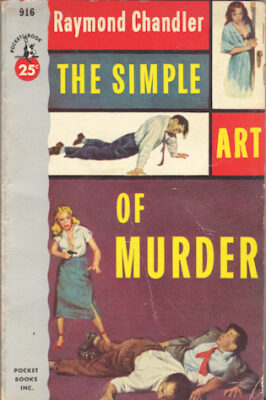A splash of cold witch hazel: Raymond Chandler’s prose
 Raymond Chandler, who some people consider the best writer of detective novels in English, didn’t like that sort of hyperbole at all. He thought it was just “critics’ jargon,” this separating works of literature into this sort, or that sort.
Raymond Chandler, who some people consider the best writer of detective novels in English, didn’t like that sort of hyperbole at all. He thought it was just “critics’ jargon,” this separating works of literature into this sort, or that sort.
But last week, bored and recovering from illness, I reached out to my shelf, and for no particular reason, “The Long Goodbye,” Chandler’s 1953 novel, came to hand. I began rereading:
“The first time I laid eyes on Terry Lennox he was drunk in a Rolls-Royce Silver Wraith outside the terrace of The Dancers. The parking lot attendant had brought the car out and he was still holding the door open because Terry Lennox’s left foot was still dangling outside, as if he had forgotten he had one. He had a young-looking face but his hair was bone white. You could tell by his eyes that he was plastered to the hairline …”
Holy cow! In three and a half silky sentences, Raymond Chandler dares you to look away. His writing is catnip. It all pivots on Terry Lennox’s left foot, the one he may have forgotten he had.
His similes and metaphors, idioms, wisecracks, along with hyperbole, personification and understatement are among the techniques he used to make his prose unforgettable. He creates emotion through dialogue and description.

CLASSICALLY EDUCATED, Raymond Chandler also studied the street language of Los Angeles.
Image by alittleblackegg is licensed under CC BY-NC-SA 2.0
Four paragraphs later, in that opening sequence of “The Long Goodbye,” the girl (of course there was a girl in that Rolls-Royce) responds to the parking lot guy: “She gave him a look which ought to have stuck at least four inches out of his back.”
His language is a tonic. A splash of cold witch hazel in the face on a hot morning.
“… and the color of her hair was a dusky red, like a fire under control but still dangerous.” (from “Trouble is My Business”).
“It was a blond. A blond to make a bishop kick a hole in a stained-glass window” (from “Farewell My Lovely”).
In “The Big Sleep,” Chandler’s detective Marlowe is invited into a greenhouse to speak to his new client, General Sternwood: “The plants filled the place, a forest of them, with nasty meaty leaves and stalks like the newly washed fingers of dead men.” You get the picture. This is no Eden.
Chandler, born in the U.S. in 1888, was classically educated in secondary school at Dulwich College in Dulwich, London. He read Livy, Ovid, and Virgil in Latin, and Thucydides, Plato and Aristotle in Greek. He translated texts from Latin to English, and then, after an interval, from English to Latin. He studied French and German, too, and he lived in each country to become fluent.
I am enthralled by the idea that the writer studied the street language of Los Angeles and played with it, as he did Latin and Greek. “I’m an intellectual snob who happens to have a fondness for the American vernacular, largely because I grew up in Latin and Greek,” he has been quoted as saying. “It would seem that a classical education might be a poor basis for writing novels in a hard-boiled vernacular,” he said, “I happen to believe otherwise.”
Chandler, who died in 1959, wrote an essay in the “Atlantic Monthly” in 1944 called “The Simple Art of Murder.” In it, he has little praise for the genteel practitioners of his trade, like Agatha Christie and Dorothy Sayers. He wrote, famously, “The English may not always be the best writers in the world, but they are incomparably the best dull writers.” But he does have praise for an American predecessor, Dashiell Hammett.
Hammett, he writes, “took murder out of the Venetian vase and dropped it into the alley …”
Category: Real Estate
